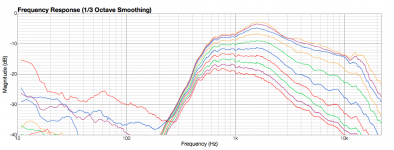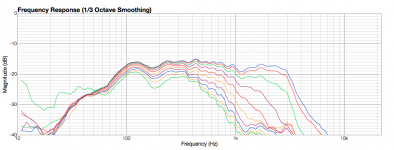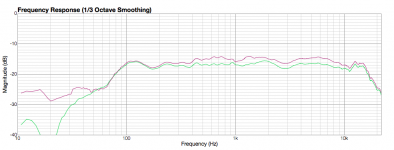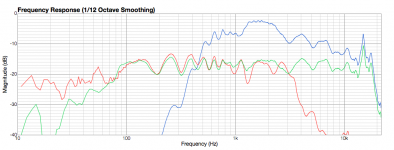Don't get too excited just yet, Inductor. For now I only have seen measurements, it'll take a couple of days before I get to hear them. And after that, endless fiddling with small adjustments in the crossover.
Once in a while people end up praising Tannoy coaxials, but looking at the measured response curves I don't know where is the merit ?
Maybe of interest for example Tannoy Super Red Monitor 15" SRM15X, manufacturer's specification response.
It is hardy 'smooth' above 2 kHz, and certainly not 'flat'. Response includes the effect of the cross over and response shaping networks.
Maybe not better overall than the currently available other brand drivers, after proper cross over and correction network ?

.
Maybe of interest for example Tannoy Super Red Monitor 15" SRM15X, manufacturer's specification response.
It is hardy 'smooth' above 2 kHz, and certainly not 'flat'. Response includes the effect of the cross over and response shaping networks.
Maybe not better overall than the currently available other brand drivers, after proper cross over and correction network ?
.
Attachments
Once in a while people end up praising Tannoy coaxials, but looking at the measured response curves I don't know where is the merit ?
Maybe of interest for example Tannoy Super Red Monitor 15" SRM15X, manufacturer's specification response.
It is hardy 'smooth' above 2 kHz, and certainly not 'flat'. Response includes the effect of the cross over and response shaping networks.
The Tannoys do have their merits. Listen to them, don't judge them by their 'curves'. Though I admit to being a bit bewildered by that inherent loudness-curve of theirs, which seems persistent through many different versions. Maybe it's intentional?
One thing the Tannoys do very differently comparing to most of the PA-crop is the horn to cone transition. It's much more smooth and consistent than any of the PA-drivers I've seen have. And at least the ones I've heard do sound really good. Not flawless - no loudspeaker is - but very good nonetheless.
And even though that response curve you show has some quite obvious wiggles, it is still quite smooth for a coaxial. Take a look at e.g. Beyma's 15XA38Nd's FR plot.
Elias, +/- 2dB is pretty good, not many modern speakers can do this without DSP correction. It speaks for the company that they show the results on a 5dB grid, usually it is 10dB, which obviously makes things look much better.
The Tannoys do have their merits. Listen to them, don't judge them by their 'curves'. Though I admit to being a bit bewildered by that inherent loudness-curve of theirs, which seems persistent through many different versions. Maybe it's intentional?
One thing the Tannoys do very differently comparing to most of the PA-crop is the horn to cone transition. It's much more smooth and consistent than any of the PA-drivers I've seen have. And at least the ones I've heard do sound really good. Not flawless - no loudspeaker is - but very good nonetheless.
And even though that response curve you show has some quite obvious wiggles, it is still quite smooth for a coaxial. Take a look at e.g. Beyma's 15XA38Nd's FR plot.
I don't have anything against Tannoy personally. I think they are beautiful speakers.
My point is I think it is possible to do similar performance speaker with other brand drivers. By technical terms. Emotional aspects aside, as they may be harder to beat.
Tannoy published curve has no sharp edges because of heavy smoothing due to it being marketing material. It looks smooth for that reason.
Some PA coaxials have intentional difraction throath (like Beyma) in order to achieve wider polar response. Wide polar response can be important in their intended application.
.
Elias, +/- 2dB is pretty good, not many modern speakers can do this without DSP correction. It speaks for the company that they show the results on a 5dB grid, usually it is 10dB, which obviously makes things look much better.
Well, that Tannoy plot has major grid of 10 dB. "potentiometer range 50 dB" as written in the plot.
.
Elias, it is very difficult to decipher, but if it is on a 10dB grid, it is indeed not something to write home about.
Yesterday afternoon was full of crossovers with Adolf Corkscrew. I have done this few times before and I know very well that the first prototype-xover that has been done for a speaker meters from ground is not the final one. It does need tuning in typical livingroom enviroment.
But dammit, this was a difficult one. Two major hiccups: 1) because of different schematics the crossover does not react to changing one part to bigger or smaller as I have used to (I am not that muh pro in this, just more of a hobby) and 2) after I got hold of the xover and was able to adjust the tone the way I needed there was all the time a certain harshess/impurity in high frequencies that bothered me all the time. It's not severe, but it is there.
Is B&C 15FCX76 a lost case? Don't know, hopefully not. Adolf took them to his home and continues with different filters. There are many good big loudspeaker and coaxial loudspeaker features in the sound. It's easy. Bass is both full and hits hard. Imaging is very natural. But that something in upper frequencies that keeps smearing S-tones. Dammit...
Adolf, your turn.
But dammit, this was a difficult one. Two major hiccups: 1) because of different schematics the crossover does not react to changing one part to bigger or smaller as I have used to (I am not that muh pro in this, just more of a hobby) and 2) after I got hold of the xover and was able to adjust the tone the way I needed there was all the time a certain harshess/impurity in high frequencies that bothered me all the time. It's not severe, but it is there.
Is B&C 15FCX76 a lost case? Don't know, hopefully not. Adolf took them to his home and continues with different filters. There are many good big loudspeaker and coaxial loudspeaker features in the sound. It's easy. Bass is both full and hits hard. Imaging is very natural. But that something in upper frequencies that keeps smearing S-tones. Dammit...
Adolf, your turn.
Here are some measurements (1/3th octave smoothing). High frequency raw responces, low frequency raw responces (0, 10, 20...90 degrees) and responce with two crossover versions. Btw. Don't look the graphs under, say, 300Hz. The "measuring ladder" is not high enough to give accurate data in bass frequencies.
15-incher is a big loudspeaker and that means there is also plenty of directivity. If you make a flat responce in anechoic enviroment, the product will sound very heavy and slow in normal room. Why? Because mid and high frequency are directional i.e. the room does not affect them too much. But bass is still omnidirectional and the room boost it a lot. Therefore the bass in anechoic measurement must be a bit lower than mid and highs to compensate room boost and also floor boost.
The 1/3th octave measurements do look very nice but when I change to 1/12th octave smoothing the problem is easily visible. The ups and downs below 1kHz are the mud reflection (the not high enough measuring stool) and to me it is easier to look through it than shorten the window and loose all the info of the bass.
But with typical quality horn + compression driver the high frequencies are smooth and that is not the case here. How much is the raggedness of 1.5k->10k and how much is the spike in about 15k...
15-incher is a big loudspeaker and that means there is also plenty of directivity. If you make a flat responce in anechoic enviroment, the product will sound very heavy and slow in normal room. Why? Because mid and high frequency are directional i.e. the room does not affect them too much. But bass is still omnidirectional and the room boost it a lot. Therefore the bass in anechoic measurement must be a bit lower than mid and highs to compensate room boost and also floor boost.
The 1/3th octave measurements do look very nice but when I change to 1/12th octave smoothing the problem is easily visible. The ups and downs below 1kHz are the mud reflection (the not high enough measuring stool) and to me it is easier to look through it than shorten the window and loose all the info of the bass.
But with typical quality horn + compression driver the high frequencies are smooth and that is not the case here. How much is the raggedness of 1.5k->10k and how much is the spike in about 15k...
Attachments
Nice to see a full set of polars! It looks like 10deg steps. Could you post that set of polar data in 1/12 or 1/24 octave smoothing? I think the higher resolution graph you show might explain the harshness you're hearing. Also, even though the pattern is pretty narrow (around 70deg at 10khz?) in my experience the top octaves can sound a bit bright with a cd-like speaker and need minus a couple dB slope towards hf.
Also, even though the pattern is pretty narrow (around 70deg at 10khz?) in my experience the top octaves can sound a bit bright with a cd-like speaker and need minus a couple dB slope towards hf.
How do you determine that - I have always wondered, is there a standard? Looks like -12dB is the limit?
But with typical quality horn + compression driver the high frequencies are smooth and that is not the case here. How much is the raggedness of 1.5k->10k and how much is the spike in about 15k...
yes, the filter has some problems. 😱
You are "playing to the average" - where the "average" results in broad peaks of 5 db or more. Don't do this. 😉
Fix the high-pass so that you don't have that "bump" from 1.4 to 2.6 kHz.
After that's done.
"Shelve" the response from 3.3 to 6.3 kHz. Don't worry that you have depressions beyond the resulting average - they aren't as easy to hear.
Finally, consider a very narrow-band "notch" for the 15 kHz spike.
Also,
Perceptually this isn't correct.
More directive speakers sound louder in their more directive regions, despite having less intensity added by the room (at the listening position). This gives that "forward"/louder character. (..it tends to make people hearing Klipsch loudspeakers for the first time exclaim something like: "oh god, make it stop!".) It's also why you'll see the treble region depressed in most older coaxial designs, NOT because they couldn't have increased the intensity of the treble.
If anything you should be adding a bit more for baffle step compensation than usual (..though not a lot). As usually though, it should be "weighted" toward the lower midrange/upper bass with a gradual freq. balance "tilt" down-ward as freq.s ascend. The only problem with all this is that no matter what, that diffraction signature around 900 Hz is going to make things a bit forward.
Unless you are placing the driver very near the floor you are going to get floor-bounce suck-out no matter what - it's NOT something that should be compensated for in single-driver (mid/bass) design like this. (..it just doesn't work.) Perhaps the best solution however is near the floor - angled-up to the listener. (..the lower edge of the driver about a foot above the floor).
..If you make a flat responce in anechoic enviroment, the product will sound very heavy and slow in normal room. Why? Because mid and high frequency are directional i.e. the room does not affect them too much. But bass is still omnidirectional and the room boost it a lot. Therefore the bass in anechoic measurement must be a bit lower than mid and highs to compensate room boost and also floor boost.
Perceptually this isn't correct.
More directive speakers sound louder in their more directive regions, despite having less intensity added by the room (at the listening position). This gives that "forward"/louder character. (..it tends to make people hearing Klipsch loudspeakers for the first time exclaim something like: "oh god, make it stop!".) It's also why you'll see the treble region depressed in most older coaxial designs, NOT because they couldn't have increased the intensity of the treble.
If anything you should be adding a bit more for baffle step compensation than usual (..though not a lot). As usually though, it should be "weighted" toward the lower midrange/upper bass with a gradual freq. balance "tilt" down-ward as freq.s ascend. The only problem with all this is that no matter what, that diffraction signature around 900 Hz is going to make things a bit forward.
Unless you are placing the driver very near the floor you are going to get floor-bounce suck-out no matter what - it's NOT something that should be compensated for in single-driver (mid/bass) design like this. (..it just doesn't work.) Perhaps the best solution however is near the floor - angled-up to the listener. (..the lower edge of the driver about a foot above the floor).
Last edited:
We'll see where this expedition takes us. The HF side of the 15FCX76 didn't sound half as bad as I feared, but it did have this certain glare to it, that certainly was a departure from neutral. I'll have to make a visit to a dealer for some components to start my own experiments with the crossover, but even though our first experiments were somewhat discouraging, that's kind of what I've come to expect with high efficiency drivers during the last few years.
No crossover I've done has been ready before a 6 month listen, measure & fiddle -period. Even if the first attempt was slightly discouraging doesn't mean it's a dead end.
No crossover I've done has been ready before a 6 month listen, measure & fiddle -period. Even if the first attempt was slightly discouraging doesn't mean it's a dead end.
No crossover I've done has been ready before a 6 month listen, measure & fiddle -period. Even if the first attempt was slightly discouraging doesn't mean it's a dead end.
This is why they should all be prototyped digitally (listened to in stereo). 😉
Honestly, once you've gone this route the former seems like the proverbial "Dark Ages". 😀
-plus, you can boast that you've heard over 100 different crossover's after extensive modeling (..and actually be honest about it).
Last edited:
How do you determine that - I have always wondered, is there a standard? Looks like -12dB is the limit?
-6dB is the standard when looking at the half angle. It looks like he's at about 35deg -6dB (if those are in fact 10deg increments) at 10khz which would be 70deg.
This is why they should all be prototyped digitally (listened to in stereo). 😉
Honestly, once you've gone this route the former seems like the proverbial "Dark Ages". 😀
-plus, you can boast that you've heard over 100 different crossover's after extensive modeling (..and actually be honest about it).
This is very true...there's a lot of potential in these. It would be trivial to come up with a workable crossover and whatever eq profile fits your room best. Minidsp for prototyping would be well worth the expense and time saved.
You can easily get time aligned and/or transient perfect crossovers in a few clicks.
I'd also say dsp prototyping is mandatory. It makes it rather easy, what would otherwise be very difficult, to find the best filtering scheme that is doable passively.
The "high end peak" is almost 10dB louder than it's neighborhood, and it's very high Q spike, that will sound ackward. I'd propably, without hearing the speaker, revisit the overall balance by tapering off the hf ~2-3dBs, CD-ish type of speakers sound somewhat bright if anechoic 0deg response is flat. By doing this the hf spike might also reduce from ackward to acceptable "house sound" and one could leave it alone (a tad of wishful thinking). 🙂
The "high end peak" is almost 10dB louder than it's neighborhood, and it's very high Q spike, that will sound ackward. I'd propably, without hearing the speaker, revisit the overall balance by tapering off the hf ~2-3dBs, CD-ish type of speakers sound somewhat bright if anechoic 0deg response is flat. By doing this the hf spike might also reduce from ackward to acceptable "house sound" and one could leave it alone (a tad of wishful thinking). 🙂
Last edited:
- Home
- Loudspeakers
- Multi-Way
- The umpteenth large format coaxial driver thread




